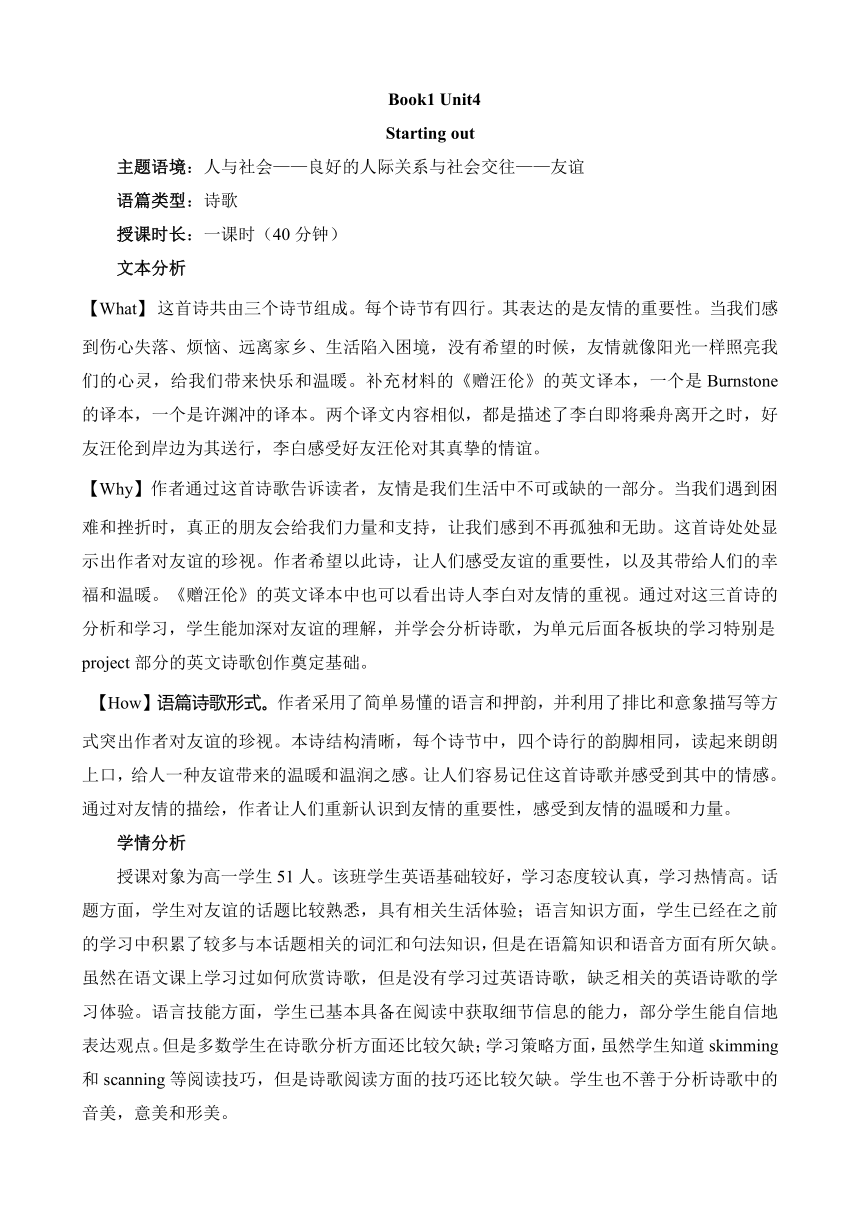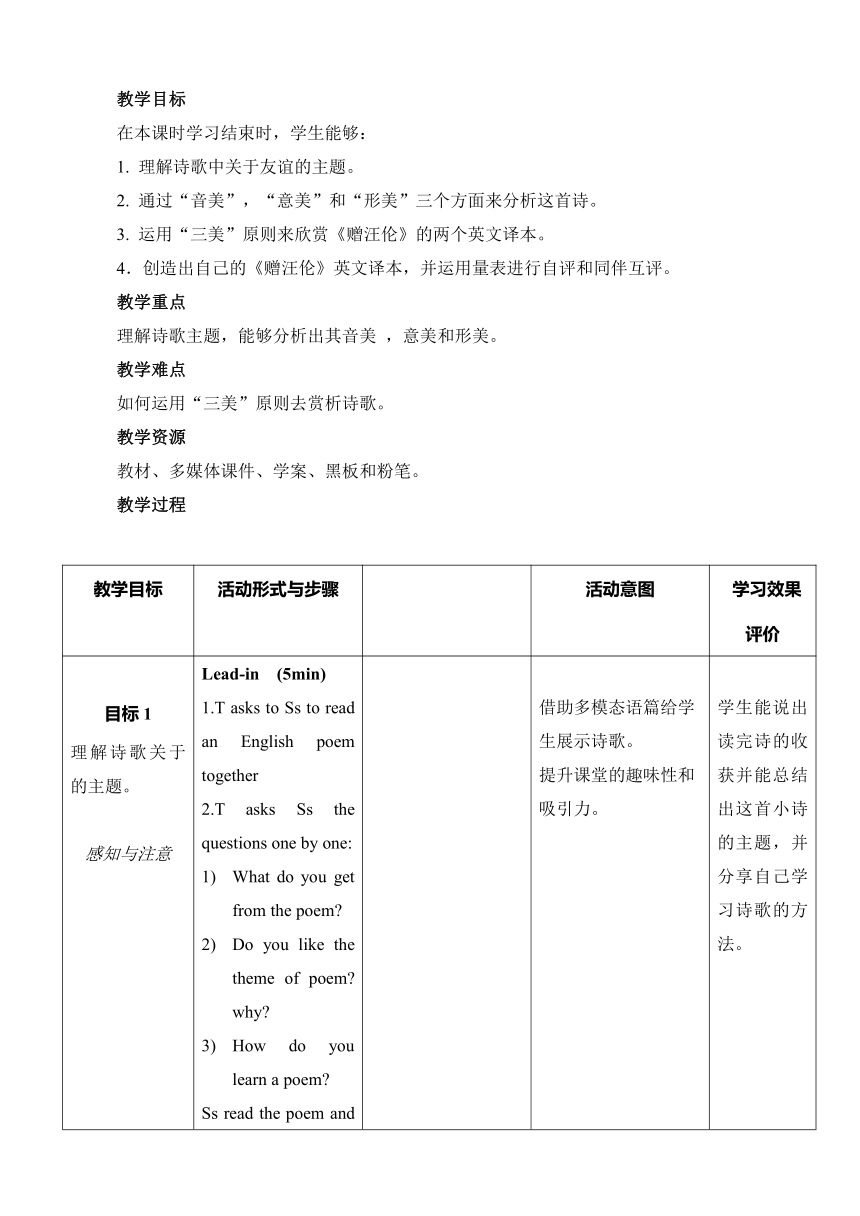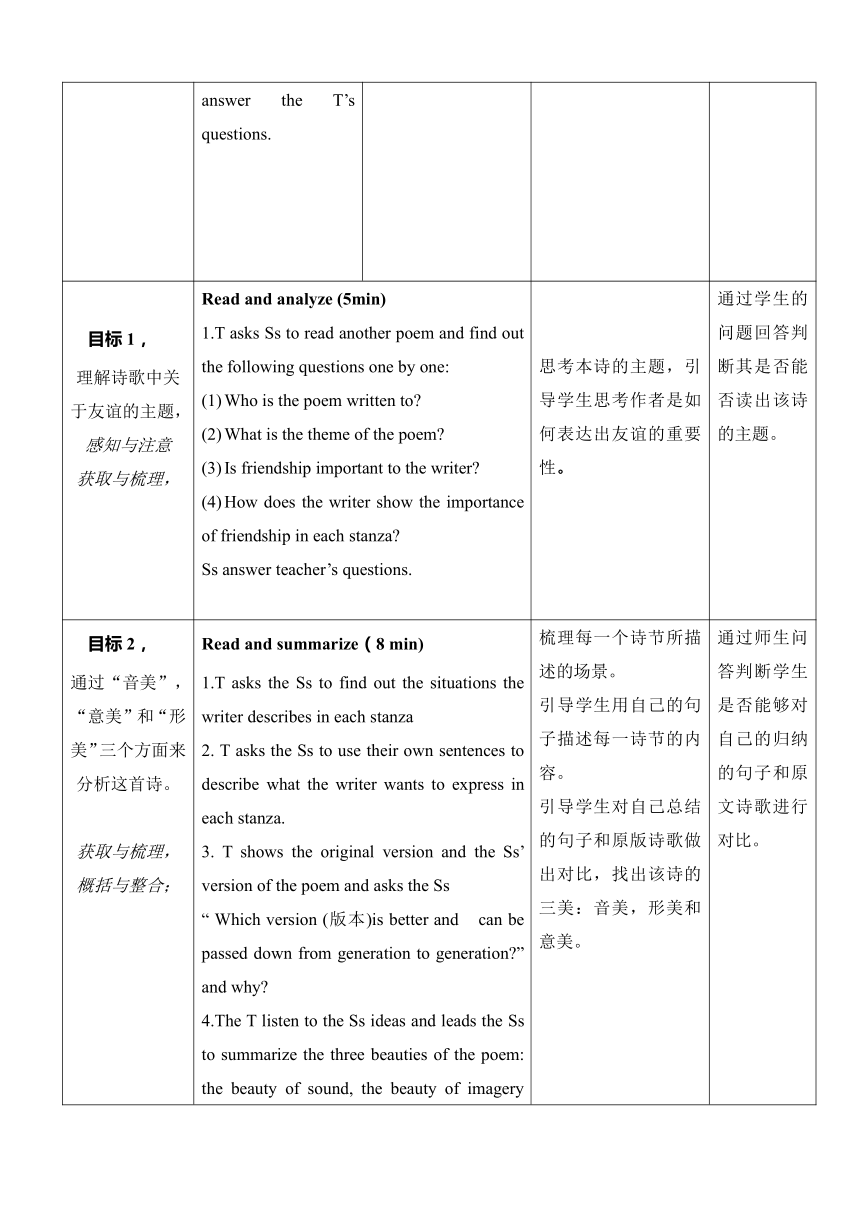外研版(2019) 必修 第一册 Unit 4 Friends forever Starting out教学设计
文档属性
| 名称 | 外研版(2019) 必修 第一册 Unit 4 Friends forever Starting out教学设计 |  | |
| 格式 | docx | ||
| 文件大小 | 29.7KB | ||
| 资源类型 | 教案 | ||
| 版本资源 | 外研版(2019) | ||
| 科目 | 英语 | ||
| 更新时间 | 2023-07-15 14:44:20 | ||
图片预览



文档简介
Book1 Unit4
Starting out
主题语境:人与社会——良好的人际关系与社会交往——友谊
语篇类型:诗歌
授课时长:一课时(40分钟)
文本分析
【What】 这首诗共由三个诗节组成。每个诗节有四行。其表达的是友情的重要性。当我们感到伤心失落、烦恼、远离家乡、生活陷入困境,没有希望的时候,友情就像阳光一样照亮我们的心灵,给我们带来快乐和温暖。补充材料的《赠汪伦》的英文译本,一个是Burnstone的译本,一个是许渊冲的译本。两个译文内容相似,都是描述了李白即将乘舟离开之时,好友汪伦到岸边为其送行,李白感受好友汪伦对其真挚的情谊。
【Why】作者通过这首诗歌告诉读者,友情是我们生活中不可或缺的一部分。当我们遇到困难和挫折时,真正的朋友会给我们力量和支持,让我们感到不再孤独和无助。这首诗处处显示出作者对友谊的珍视。作者希望以此诗,让人们感受友谊的重要性,以及其带给人们的幸福和温暖。《赠汪伦》的英文译本中也可以看出诗人李白对友情的重视。通过对这三首诗的分析和学习,学生能加深对友谊的理解,并学会分析诗歌,为单元后面各板块的学习特别是project部分的英文诗歌创作奠定基础。
【How】语篇诗歌形式。作者采用了简单易懂的语言和押韵,并利用了排比和意象描写等方式突出作者对友谊的珍视。本诗结构清晰,每个诗节中,四个诗行的韵脚相同,读起来朗朗上口,给人一种友谊带来的温暖和温润之感。让人们容易记住这首诗歌并感受到其中的情感。通过对友情的描绘,作者让人们重新认识到友情的重要性,感受到友情的温暖和力量。
学情分析
授课对象为高一学生51人。该班学生英语基础较好,学习态度较认真,学习热情高。话题方面,学生对友谊的话题比较熟悉,具有相关生活体验;语言知识方面,学生已经在之前的学习中积累了较多与本话题相关的词汇和句法知识,但是在语篇知识和语音方面有所欠缺。虽然在语文课上学习过如何欣赏诗歌,但是没有学习过英语诗歌,缺乏相关的英语诗歌的学习体验。语言技能方面,学生已基本具备在阅读中获取细节信息的能力,部分学生能自信地表达观点。但是多数学生在诗歌分析方面还比较欠缺;学习策略方面,虽然学生知道skimming和scanning等阅读技巧,但是诗歌阅读方面的技巧还比较欠缺。学生也不善于分析诗歌中的音美,意美和形美。
教学目标
在本课时学习结束时,学生能够:
1. 理解诗歌中关于友谊的主题。
2. 通过“音美”,“意美”和“形美”三个方面来分析这首诗。
3. 运用“三美”原则来欣赏《赠汪伦》的两个英文译本。
4.创造出自己的《赠汪伦》英文译本,并运用量表进行自评和同伴互评。
教学重点
理解诗歌主题,能够分析出其音美 ,意美和形美。
教学难点
如何运用“三美”原则去赏析诗歌。
教学资源
教材、多媒体课件、学案、黑板和粉笔。
教学过程
教学目标 活动形式与步骤 活动意图 学习效果评价
目标1 理解诗歌关于的主题。 感知与注意 Lead-in (5min) 1.T asks to Ss to read an English poem together 2.T asks Ss the questions one by one: What do you get from the poem Do you like the theme of poem why How do you learn a poem Ss read the poem and answer the T’s questions. 借助多模态语篇给学生展示诗歌。 提升课堂的趣味性和吸引力。 学生能说出读完诗的收获并能总结出这首小诗的主题,并分享自己学习诗歌的方法。
目标1, 理解诗歌中关于友谊的主题, 感知与注意 获取与梳理, Read and analyze (5min) 1.T asks Ss to read another poem and find out the following questions one by one: Who is the poem written to What is the theme of the poem Is friendship important to the writer How does the writer show the importance of friendship in each stanza Ss answer teacher’s questions. 思考本诗的主题,引导学生思考作者是如何表达出友谊的重要性。 通过学生的问题回答判断其是否能否读出该诗的主题。
目标2, 通过“音美”,“意美”和“形美”三个方面来分析这首诗。 获取与梳理, 概括与整合; Read and summarize(8 min) 1.T asks the Ss to find out the situations the writer describes in each stanza 2. T asks the Ss to use their own sentences to describe what the writer wants to express in each stanza. 3. T shows the original version and the Ss’ version of the poem and asks the Ss “ Which version (版本)is better and can be passed down from generation to generation ” and why 4.The T listen to the Ss ideas and leads the Ss to summarize the three beauties of the poem: the beauty of sound, the beauty of imagery and the beauty of pattern. 5. T asks the Ss to read the poem aloud again and feel the beauty of the poem. 1.Ss find out the situations the writer describes in each stanza 2. Ss use their own sentences to describe what the writer wants to express in each stanza. 3.Ss compare their version of the poem with the original version. 4.Ss summarize the three beauties of the poem under the T’s guidance. 5.Ss read the poem aloud again and feel the beauty of the poem. 梳理每一个诗节所描述的场景。 引导学生用自己的句子描述每一诗节的内容。 引导学生对自己总结的句子和原版诗歌做出对比,找出该诗的三美:音美,形美和意美。 通过师生问答判断学生是否能够对自己的归纳的句子和原文诗歌进行对比。
目标3 运用“三美”原则来欣赏《赠汪伦》的两个英文译本。 分析与判断 内化与运用 Read and apply (9 min) 1.T asks the Ss the 2questions: “Do you like the theme of the poem---friendship Do you know any Chinese poem that talks about friendship ” T asks Ss to share the name of the Chinese poems that talks about friendship with their group members. T listen to and evaluate Ss’ answers orally and shows 2 English version of Chinese poems To Wanglun and asks Ss to work in groups to compare and appreciate the 2 versions through the beauty of sound, the beauty of imagery and the beauty of pattern and judge which one is better. 1.Ss answer the T’s questions and share the name of the Chinese poems that talk about friendship. 2.Ss read and appreciate the 2 English versions of To WangLun through the beauty of sound, the beauty of imagery and the beauty of pattern and judge which version is better and explain why. 培养学生的诗歌鉴赏力和引导学生运用所学的欣赏诗歌的“三美”原则去欣赏其他的诗歌。 通过观察学生的小组讨论表现,倾听学生的阐出的答案,判断学生是否掌握了欣赏诗歌的“三美”原则。
目标4. 创造出自己的《赠汪伦》英文译本。 想象与创造 Create ( 10 min) T asks the Ss to try to create their English version of To Wang Lun and try to apply “three beauties” in their poems. Ss think about their version and get prepared to create their English version of To Wanglun on their handout. 引导学生进行知识的迁移和创新。利用所学的三美原则创造出自己的《赠汪伦》的英译版本。 进行课堂观察。观察学生的创作过程,对其提供指导和帮助,在帮助中评价学生的创作。
目标4 运用量表进行自评和同伴互评。 批判与评价 T shows some Ss’ versions of To Wang Lun and give evaluations. T asks Ss to reflect and evaluate their performance according to the self-reflection form on their handout. Ss reflect and evaluate their performance according to the self-reflection form on their handout. 通过量表1让学生反思本节课的学习目标是否达成。 通过量表2 让学生进行自己创作的《赠汪伦》译文的自评和互评。 观察学生的课堂表现,作品呈现情况和反思表现情况以及根据量表数据判断本节课的教学目标是否已经达成。
Homework:
Polish your version of To Wang Lun by applying “the three beauties”.
Self-reflection at the end of the class
After this lesson, I am able to: Self -evaluation
1. Understand the theme of the poem that friendship is of great importance. 1 2 3 4 5
2.Analyse the poem from the beauty of sound, the beauty of imagery and the beauty of pattern. 1 2 3 4 5
3. Apply the “3 beauties” to appreciate more poems. 1 2 3 4 5
4.Create an English version of To Wang Lun . 1 2 3 4 5
TOTAL Grade
Evaluation for your version of To Wang Lun
Questions Your evaluation Evaluator
Does the version have the beauty of sound 1 2 3 4 5
Does the version have the beauty of imagery 1 2 3 4 5
Does the version have the beauty of pattern 1 2 3 4 5
How is the handwriting 1 2 3 4 5
TOTAL Grade
Blackboard Design
Starting out
Homer’s Epic sung by people before the written language was invented
Book of Songs
Rhyming words: low, know, hello, glow, [ ] ([b], [k]…)
new, view, you, through[u]
night, right, delight, bright[ait]
the beauty of sound
imagery
pattern
Starting out
主题语境:人与社会——良好的人际关系与社会交往——友谊
语篇类型:诗歌
授课时长:一课时(40分钟)
文本分析
【What】 这首诗共由三个诗节组成。每个诗节有四行。其表达的是友情的重要性。当我们感到伤心失落、烦恼、远离家乡、生活陷入困境,没有希望的时候,友情就像阳光一样照亮我们的心灵,给我们带来快乐和温暖。补充材料的《赠汪伦》的英文译本,一个是Burnstone的译本,一个是许渊冲的译本。两个译文内容相似,都是描述了李白即将乘舟离开之时,好友汪伦到岸边为其送行,李白感受好友汪伦对其真挚的情谊。
【Why】作者通过这首诗歌告诉读者,友情是我们生活中不可或缺的一部分。当我们遇到困难和挫折时,真正的朋友会给我们力量和支持,让我们感到不再孤独和无助。这首诗处处显示出作者对友谊的珍视。作者希望以此诗,让人们感受友谊的重要性,以及其带给人们的幸福和温暖。《赠汪伦》的英文译本中也可以看出诗人李白对友情的重视。通过对这三首诗的分析和学习,学生能加深对友谊的理解,并学会分析诗歌,为单元后面各板块的学习特别是project部分的英文诗歌创作奠定基础。
【How】语篇诗歌形式。作者采用了简单易懂的语言和押韵,并利用了排比和意象描写等方式突出作者对友谊的珍视。本诗结构清晰,每个诗节中,四个诗行的韵脚相同,读起来朗朗上口,给人一种友谊带来的温暖和温润之感。让人们容易记住这首诗歌并感受到其中的情感。通过对友情的描绘,作者让人们重新认识到友情的重要性,感受到友情的温暖和力量。
学情分析
授课对象为高一学生51人。该班学生英语基础较好,学习态度较认真,学习热情高。话题方面,学生对友谊的话题比较熟悉,具有相关生活体验;语言知识方面,学生已经在之前的学习中积累了较多与本话题相关的词汇和句法知识,但是在语篇知识和语音方面有所欠缺。虽然在语文课上学习过如何欣赏诗歌,但是没有学习过英语诗歌,缺乏相关的英语诗歌的学习体验。语言技能方面,学生已基本具备在阅读中获取细节信息的能力,部分学生能自信地表达观点。但是多数学生在诗歌分析方面还比较欠缺;学习策略方面,虽然学生知道skimming和scanning等阅读技巧,但是诗歌阅读方面的技巧还比较欠缺。学生也不善于分析诗歌中的音美,意美和形美。
教学目标
在本课时学习结束时,学生能够:
1. 理解诗歌中关于友谊的主题。
2. 通过“音美”,“意美”和“形美”三个方面来分析这首诗。
3. 运用“三美”原则来欣赏《赠汪伦》的两个英文译本。
4.创造出自己的《赠汪伦》英文译本,并运用量表进行自评和同伴互评。
教学重点
理解诗歌主题,能够分析出其音美 ,意美和形美。
教学难点
如何运用“三美”原则去赏析诗歌。
教学资源
教材、多媒体课件、学案、黑板和粉笔。
教学过程
教学目标 活动形式与步骤 活动意图 学习效果评价
目标1 理解诗歌关于的主题。 感知与注意 Lead-in (5min) 1.T asks to Ss to read an English poem together 2.T asks Ss the questions one by one: What do you get from the poem Do you like the theme of poem why How do you learn a poem Ss read the poem and answer the T’s questions. 借助多模态语篇给学生展示诗歌。 提升课堂的趣味性和吸引力。 学生能说出读完诗的收获并能总结出这首小诗的主题,并分享自己学习诗歌的方法。
目标1, 理解诗歌中关于友谊的主题, 感知与注意 获取与梳理, Read and analyze (5min) 1.T asks Ss to read another poem and find out the following questions one by one: Who is the poem written to What is the theme of the poem Is friendship important to the writer How does the writer show the importance of friendship in each stanza Ss answer teacher’s questions. 思考本诗的主题,引导学生思考作者是如何表达出友谊的重要性。 通过学生的问题回答判断其是否能否读出该诗的主题。
目标2, 通过“音美”,“意美”和“形美”三个方面来分析这首诗。 获取与梳理, 概括与整合; Read and summarize(8 min) 1.T asks the Ss to find out the situations the writer describes in each stanza 2. T asks the Ss to use their own sentences to describe what the writer wants to express in each stanza. 3. T shows the original version and the Ss’ version of the poem and asks the Ss “ Which version (版本)is better and can be passed down from generation to generation ” and why 4.The T listen to the Ss ideas and leads the Ss to summarize the three beauties of the poem: the beauty of sound, the beauty of imagery and the beauty of pattern. 5. T asks the Ss to read the poem aloud again and feel the beauty of the poem. 1.Ss find out the situations the writer describes in each stanza 2. Ss use their own sentences to describe what the writer wants to express in each stanza. 3.Ss compare their version of the poem with the original version. 4.Ss summarize the three beauties of the poem under the T’s guidance. 5.Ss read the poem aloud again and feel the beauty of the poem. 梳理每一个诗节所描述的场景。 引导学生用自己的句子描述每一诗节的内容。 引导学生对自己总结的句子和原版诗歌做出对比,找出该诗的三美:音美,形美和意美。 通过师生问答判断学生是否能够对自己的归纳的句子和原文诗歌进行对比。
目标3 运用“三美”原则来欣赏《赠汪伦》的两个英文译本。 分析与判断 内化与运用 Read and apply (9 min) 1.T asks the Ss the 2questions: “Do you like the theme of the poem---friendship Do you know any Chinese poem that talks about friendship ” T asks Ss to share the name of the Chinese poems that talks about friendship with their group members. T listen to and evaluate Ss’ answers orally and shows 2 English version of Chinese poems To Wanglun and asks Ss to work in groups to compare and appreciate the 2 versions through the beauty of sound, the beauty of imagery and the beauty of pattern and judge which one is better. 1.Ss answer the T’s questions and share the name of the Chinese poems that talk about friendship. 2.Ss read and appreciate the 2 English versions of To WangLun through the beauty of sound, the beauty of imagery and the beauty of pattern and judge which version is better and explain why. 培养学生的诗歌鉴赏力和引导学生运用所学的欣赏诗歌的“三美”原则去欣赏其他的诗歌。 通过观察学生的小组讨论表现,倾听学生的阐出的答案,判断学生是否掌握了欣赏诗歌的“三美”原则。
目标4. 创造出自己的《赠汪伦》英文译本。 想象与创造 Create ( 10 min) T asks the Ss to try to create their English version of To Wang Lun and try to apply “three beauties” in their poems. Ss think about their version and get prepared to create their English version of To Wanglun on their handout. 引导学生进行知识的迁移和创新。利用所学的三美原则创造出自己的《赠汪伦》的英译版本。 进行课堂观察。观察学生的创作过程,对其提供指导和帮助,在帮助中评价学生的创作。
目标4 运用量表进行自评和同伴互评。 批判与评价 T shows some Ss’ versions of To Wang Lun and give evaluations. T asks Ss to reflect and evaluate their performance according to the self-reflection form on their handout. Ss reflect and evaluate their performance according to the self-reflection form on their handout. 通过量表1让学生反思本节课的学习目标是否达成。 通过量表2 让学生进行自己创作的《赠汪伦》译文的自评和互评。 观察学生的课堂表现,作品呈现情况和反思表现情况以及根据量表数据判断本节课的教学目标是否已经达成。
Homework:
Polish your version of To Wang Lun by applying “the three beauties”.
Self-reflection at the end of the class
After this lesson, I am able to: Self -evaluation
1. Understand the theme of the poem that friendship is of great importance. 1 2 3 4 5
2.Analyse the poem from the beauty of sound, the beauty of imagery and the beauty of pattern. 1 2 3 4 5
3. Apply the “3 beauties” to appreciate more poems. 1 2 3 4 5
4.Create an English version of To Wang Lun . 1 2 3 4 5
TOTAL Grade
Evaluation for your version of To Wang Lun
Questions Your evaluation Evaluator
Does the version have the beauty of sound 1 2 3 4 5
Does the version have the beauty of imagery 1 2 3 4 5
Does the version have the beauty of pattern 1 2 3 4 5
How is the handwriting 1 2 3 4 5
TOTAL Grade
Blackboard Design
Starting out
Homer’s Epic sung by people before the written language was invented
Book of Songs
Rhyming words: low, know, hello, glow, [ ] ([b], [k]…)
new, view, you, through[u]
night, right, delight, bright[ait]
the beauty of sound
imagery
pattern
